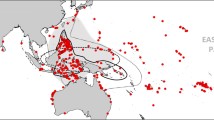Abstract
Extant coelacanths (Latimeria chalumnae) were first discovered in the western Indian Ocean in 1938; in 1998, a second species of coelacanth, Latimeria menadoensis, was discovered off the north coast of Sulawesi, Indonesia, expanding the known distribution of the genus across the Indian Ocean Basin. This study uses ecological niche modeling techniques to estimate dimensions of realized niches of coelacanths and generate hypotheses for additional sites where they might be found. Coelacanth occurrence information was integrated with environmental and oceanographic data using the Genetic Algorithm for Rule-set Production (GARP) and a maximum entropy algorithm (Maxent). Resulting models were visualized as maps of relative suitability of sites for coelacanths throughout the Indian Ocean, as well as scatterplots of ecological variables. Our findings suggest that the range of coelacanths could extend beyond their presently known distribution and suggests alternative mechanisms for currently observed distributions. Further investigation into these hypotheses could aid in forming a more complete picture of the distributions and populations of members of genus Latimeria, which in turn could aid in developing conservation strategies, particularly in the case of L. menadoensis.




Similar content being viewed by others
Abbreviations
- ENM:
-
Ecological niche modeling
- GARP:
-
Genetic algorithm for rule-set prediction
- GBIF:
-
Global biodiversity information facility
- OBIS:
-
Ocean biogeographic information system
- MESS:
-
Multivariate environmental similarity surface
References
Amante C, Eakins BW (2009) ETOPO1 1 arc-minute global relief model: procedures, data sources and analysis. NOAA Tech Mem NESDIS NGDC 24:1–19
Anderson RP, Lew D, Peterson AT (2003) Evaluating predictive models of species’ distributions: criteria for selecting optimal models. Ecol Model 162:211–232
Barve N, Barve V, Jiménez-Valverde A, Maher SP, Peterson AT, Soberón J, Villalobos F (2011) The crucial role of the accessible area in ecological niche modeling and species distribution modeling. Ecol Model 222:1810–1819
Divins, D.L. 2009. NGDC total sediment thickness of the world’s oceans and marginal seas. Available at: http://www.ngdc.noaa.gov/mgg/sedthick/sedthick.html. Accessed Dec 2009
Elith J, Kearney M, Phillips S (2010) The art of modeling range-shifting species. Methods Ecol Evol 1:330–342
Erdmann M (1999) An account of the first living coelacanth known to scientists from Indonesian waters. Environ Biol Fishes 54:439–443
Erdmann M, Caldwell R, Moosa MK (1998) Indonesian ‘king of the sea’ discovered. Nature 395:335
Erdmann M, Caldwell R, Jewett S, Tjakrawidjaja A (1999) The second recorded living coelacanth from north Sulawesi. Environ Biol Fishes 54:445–451
Fricke H, Hissmann K (2000) Feeding ecology and evolutionary survival of the living coelacanth Latimeria chalumnae. Mar Biol 136:379–386
Holder MT, Erdmann MV, Wilcox TP, Caldwell RL, Hillis DM (1999) Two living species of coelacanths? Proc Natl Acad Sci USA 96:12616–12620
IUCN (2011) IUCN red list of threatened species. www.iucnredlist.org. Cited on 14 Sep 2011
NOAA (1999) World Ocean Atlas 1998. National oceanographic data center, silver spring, MD. (3CD-ROM set)
Pearson RG, Raxworthy CJ, Nakamura M, Peterson AT (2007) Predicting species distributions from a small number of occurrence records: a test case using cryptic geckos in Madagascar. J Biogeogr 34:102–117
Peterson AT (2011) Ecological niche conservatism: a time-structured review of evidence. J Biogeogr 38:817–827
Phillips SJ, Anderson RP, Schapire RE (2006) Maximum entropy modeling of species geographic distributions. Ecol Model 190:231–259
Pulliam R (2000) On the relationship between niche and distribution. Ecol Lett 3:349–361
Raxworthy CJ, Martinez-Meyer E, Horning N, Nussbaum RA, Schneider GE, Ortega-Huerta MA, Peterson AT (2004) Predicting distributions of known and unknown reptile species in Madagascar. Nature 426:837–841
Siqueira MF, Durigan G, de Marco Júnior P, Peterson AT (2009) Something for nothing: using landscape similarity and ecological niche modeling to find rare species. J Nat Conserv 17:25–32
Smith JLB (1939) A living fish of the Mesozoic type. Nature 143:455–456
Soberón J (2007) Grinellian and Eltonian niches and geographic distributions of species. Ecol Lett 10:1–9
Soberón J, Nakamura M (2009) Niches and distributional areas: concepts, methods, and assumptions. Proc Natl Acad Sci USA 106:19644–19650
Soberón J, Peterson AT (2005) Interpretation of models of fundamental ecological niches and species’ distributional areas. Biodivers Inf 2:1–10
Springer VG (1999) Are the Indonesian and western Indian Ocean coelacanths conspecific: a prediction. Environ Biol Fish 54:453–456
Stobbs R (2002) The coelacanth and the Comores: challenging the myth. Science in Africa 16: http://www.scienceinafrica.co.za/2002/april/home.htm. Accessed 1 Feb 2011
Stockwell D, Peters D (1999) The GARP modeling systems: problems and solutions to automated spatial prediction. Int J Geogr Inf Sci 13:143–158
Wiley EO, McNyset KM, Peterson AT, Robins CR, Stewart AM (2003) Niche modeling and geographic range predictions in the marine environment using a machine-learning algorithm. Oceanography 16:120–127
Acknowledgments
Many thanks to Andrés Lira-Noriega for his input on and assistance with this project. Thanks to Aimee Stewart and Kris McNyset for generously sharing their processed World Ocean Atlas data layers, and to Ed Wiley and colleagues in the KU Biodiversity Institute Ichthyology Division, for their enthusiasm and support. Thanks are also due to T.G. Bornman and colleagues at the African Coelacanth Ecosystem Programme at the South African Institute for Aquatic Biodiversity for allowing us use of coelacanth submersible sighting coordinates, and to two anonymous reviewers for their constructive feedback.
Author information
Authors and Affiliations
Corresponding author
Rights and permissions
About this article
Cite this article
Owens, H.L., Bentley, A.C. & Peterson, A.T. Predicting suitable environments and potential occurrences for coelacanths (Latimeria spp.). Biodivers Conserv 21, 577–587 (2012). https://doi.org/10.1007/s10531-011-0202-1
Received:
Accepted:
Published:
Issue Date:
DOI: https://doi.org/10.1007/s10531-011-0202-1




